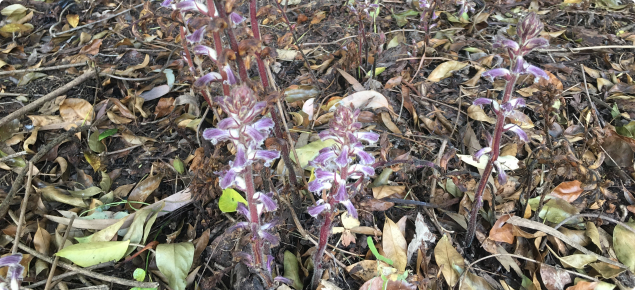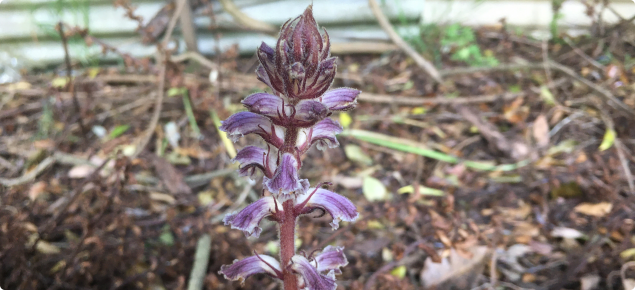Identification and attributes
Latin name - Orobanche minor
Lesser broomrape is also known as common broomrape and clover broomrape. It is the smallest species within the Orobanche genus. It is a root parasite with no true leaves; it survives by extracting nutrients from neighbouring plants, including clover and other pasture species.
Distinguishing features
This species has two cotyledons. It can grow 10-50cm tall and is erect and single-stemmed. The stem is yellow-brown or tinged with purple, thick and fleshy, swollen at the base, sticky to touch and hairy. Leaves are alternate, brown and scale-like. They are 13-22mm long by 3-6mm wide, and egg shaped or triangular.
The flower head is a dense, cylindrical spike with many tubular flowers. The flowers become denser near the top of the flower head. The flowers may be white or yellow with purple veins or pale purple and are bisexual. Petals curve outwards and downwards and are 10-20mm long.
The fruit is a slightly flattened, elliptical capsule. It is 7-10mm long, 2.5-3.5mm wide, and releases seed through two slits (often on the underside). Each fruit contains many seeds. Seeds are brown or black and tiny, less than 0.5mm long. The seeds look like dust. A plant can produce up to 500 000 seeds.
The thick, fleshy roots attach to the host plant. Each plant has a tuber or bulb-like structure below ground.
Biology
This annual plant generally germinates in autumn. However, it grows underground until it produces a flowering stem in late winter or spring. Flowering and seed production occurs from August to November. Plants die in late spring or summer. Seeds may remain dormant in the soil for up to 10 years.
The plants have no chlorophyll and are totally dependent on a host plant for nutrition. Hosts may include clover, chickpeas, capeweed, skeleton weed and a range of other plants.
Why is it a weed?
At a density of 10-20 broomrape heads/m2, this weed will reduce the dry biomass of pasture by about 20%. It is rarely eaten by stock, although it is not toxic.
Tactics for integrated weed management
There are no registered herbicides for lesser broomrape control.
The easiest way to remove this species is to kill the host. This may be appropriate in small areas, but over a large area, killing all plants would pose a risk of erosion.
Flowering stems can be removed, but it is important to monitor the area closely to target the stems before seed production.
Pre-emergent application of imazethapyr and chlorsulfuron can be applied to some crops, and provide good control of lesser broomrape.
Post-emergent application of glyphosate at low rates (100mL/ha of Roundup CT) may be suitable as a crop-topping treatment in some crops and pastures.



